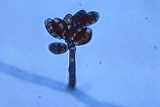
Curvularia
Encyclopedia
Curvularia is a hyphomycete (mold
) fungus which is a facultative pathogen
of many plant species and of the soil. Most Curvularia are found in tropical regions, though a few are found in temperate
zones.
Curvularia defined by the type species C. lunata (Wakker) Boedijn. Curvularia lunata appears as shiny velvety-black, fluffy growth on the colony surface. C. lunata is distinguished by septate, dematiaceous hyphae producing brown, geniculate conidiophores. The poroconidia are curved slightly to distinctly, transversely septate, with an expanded third cell from the pore end of the conidium. Curvularia can be easily distinguished from Bipolaris
and Drechslera
spp. since the conidia are non-distoseptate, that is, septate from edge to edge of the conidial wall. The teleomorphic state of the type species
Curvularia lunata is Cochliobolus lunatus (Fam. Pleosporaceae, Ord. Pleosporales, Cla. Loculoascomycetes, Phy. Ascomycota
).
lanuginosum) that enables it to thrive near hot spring
s in soil temperatures of up to 104° F (40° C). The fungus confers this protective effect only when itself infected by the Curvularia thermal tolerance virus (CThTV). Plants unrelated to panic grass also experience this protective effect when inoculated with the virus-infected fungus.
 Primary species
Primary species
of Curvularia commonly found in soils and on plant tissues (including seeds):
Mold
Molds are fungi that grow in the form of multicellular filaments called hyphae. Molds are not considered to be microbes but microscopic fungi that grow as single cells called yeasts...
) fungus which is a facultative pathogen
Pathogen
A pathogen gignomai "I give birth to") or infectious agent — colloquially, a germ — is a microbe or microorganism such as a virus, bacterium, prion, or fungus that causes disease in its animal or plant host...
of many plant species and of the soil. Most Curvularia are found in tropical regions, though a few are found in temperate
Temperate
In geography, temperate or tepid latitudes of the globe lie between the tropics and the polar circles. The changes in these regions between summer and winter are generally relatively moderate, rather than extreme hot or cold...
zones.
Curvularia defined by the type species C. lunata (Wakker) Boedijn. Curvularia lunata appears as shiny velvety-black, fluffy growth on the colony surface. C. lunata is distinguished by septate, dematiaceous hyphae producing brown, geniculate conidiophores. The poroconidia are curved slightly to distinctly, transversely septate, with an expanded third cell from the pore end of the conidium. Curvularia can be easily distinguished from Bipolaris
Bipolaris
Bipolaris is a genus of fungi belonging to the family Pleosporaceae.-Species:*Bipolaris australiensis*Bipolaris cactivora*Bipolaris cookei*Bipolaris hawaiiensis*Bipolaris incurvata*Bipolaris nodulosa*Bipolaris sacchari...
and Drechslera
Drechslera
Drechslera is a genus of fungi. Many of the species in this genus are plant pathogens. Drechslera puttaparthii is a new species found recently by Dr.Vijay Kumar. at Department of Biosciences. Sri Sathya Sai institute of higher learning. Prasanthinilayam....
spp. since the conidia are non-distoseptate, that is, septate from edge to edge of the conidial wall. The teleomorphic state of the type species
Type species
In biological nomenclature, a type species is both a concept and a practical system which is used in the classification and nomenclature of animals and plants. The value of a "type species" lies in the fact that it makes clear what is meant by a particular genus name. A type species is the species...
Curvularia lunata is Cochliobolus lunatus (Fam. Pleosporaceae, Ord. Pleosporales, Cla. Loculoascomycetes, Phy. Ascomycota
Ascomycota
The Ascomycota are a Division/Phylum of the kingdom Fungi, and subkingdom Dikarya. Its members are commonly known as the Sac fungi. They are the largest phylum of Fungi, with over 64,000 species...
).
Heat-tolerance symbiote
Curvularia protuberata is an endosymbiote of panic grass (DichantheliumDichanthelium
Dichanthelium is genus of plants of the grass family , often known as Rosette grass.The genus Dichanthelium is only weakly distinguished from the genus Panicum, and some believe it should be included in it.- Species :...
lanuginosum) that enables it to thrive near hot spring
Hot spring
A hot spring is a spring that is produced by the emergence of geothermally heated groundwater from the Earth's crust. There are geothermal hot springs in many locations all over the crust of the earth.-Definitions:...
s in soil temperatures of up to 104° F (40° C). The fungus confers this protective effect only when itself infected by the Curvularia thermal tolerance virus (CThTV). Plants unrelated to panic grass also experience this protective effect when inoculated with the virus-infected fungus.
Species

Species
In biology, a species is one of the basic units of biological classification and a taxonomic rank. A species is often defined as a group of organisms capable of interbreeding and producing fertile offspring. While in many cases this definition is adequate, more precise or differing measures are...
of Curvularia commonly found in soils and on plant tissues (including seeds):
- C. affinis
- C. brachyspora
- C. caricae-papayaeCurvularia caricae-papayaeCurvularia caricae-papayae is a plant pathogen.- External links :* *...
- C. clavata
- C. eragrostidis (Cochliobolus eragrostidis (Teleomorph))
- C. fallax
- C. geniculata (Cochliobolus geniculatus (Teleomorph))
- C. harveyi
- C. lunata (Cochliobolus lunatusCochliobolus lunatusCochliobolus lunatus is a fungal plant pathogen.- External links :* *...
(Teleomorph)) - C. ovoidea
- C. pallescens
- C. pennisetiCurvularia pennisetiCurvularia penniseti is a plant pathogen.- External links :* *...
- C. prasadii
- C. protuberataCurvularia protuberataCurvularia protuberata is a species of fungus in the Pleosporaceae family. It forms a mutualistic relationship with Dichanthelium lanuginosum and Curvularia thermal tolerance virus that allows the grass to grow in soils that are far warmer than it normally tolerates. The mutualism allows the grass...
- C. senegalensisCurvularia senegalensisCurvularia senegalensis is a plant pathogen.- External links :* *...
- C. trifoliiCurvularia trifoliiCurvularia trifolii is a plant pathogen.- External links :* *...
- C. tuberculata (Cochliobolus tuberculatus (Teleomorph))

